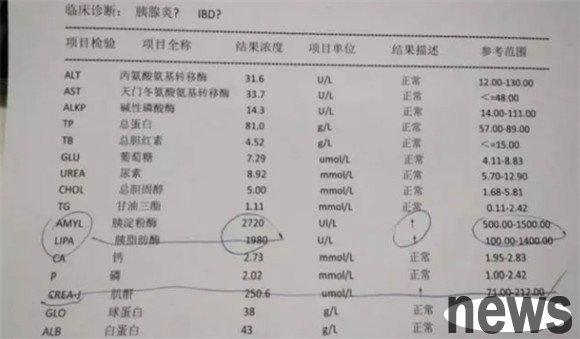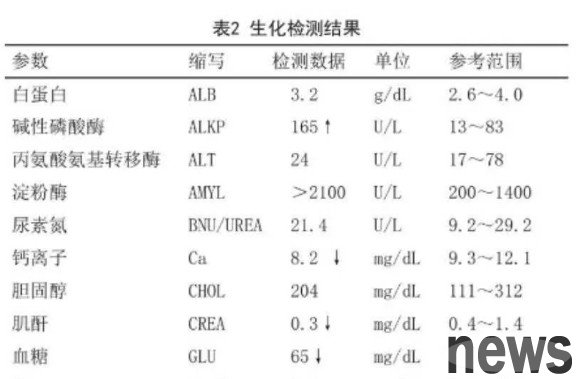In the past, common diseases in pets were mostly skin diseases or infectious diseases. As pet owners' awareness increased, this type of disease became less and less common.
Relatively speaking, some pets may experience more frequent geriatric diseases. In addition, some owners are too doting on their pets and do not feed them scientifically. In recent years, pets have become more and more common in suffering from a series of elderly diseases such as hypertension, fatty liver, and pancreatitis.

The pancreas is an exocrine gland, which mainly produces pancreatic juice and contains a variety of digestive enzymes such as amylase and lipase. It enters the duodenum through the pancreatic duct. Pancreatic islets belong to the endocrine gland, which mainly produces insulin and enters the bloodstream to regulate blood sugar balance.
Common causes of pancreatitis
Dogs:
1. In terms of nutrition, eat high-fat or high-carbohydrate foods.
2. Obesity.
3. Hyperlipoproteinemia.
4. Drug effects: sulfonamides, glucocorticoids, lev asparaginase, azathioprine, chemotherapy drugs, etc.
5, duodenal reflux.
6. Abdominal trauma, cholangitis, infectious diseases, etc.
7. Pancreatic ischemia caused by any cause.
cats:
1. The potential cause of pancreatitis in most cats is not determined, and is usually a complication of other diseases. It usually occurs with cholangitis, hepatitis and enteritis. (Trimophilia cat).
2. Histologically 2/3 of feline pancreatitis meet chronic pancreatitis cases. When pancreatitis is suspected, cholangitis, inflammatory hepatitis, inflammatory enteritis and bacterial pancreatic infections should be screened for.
3. Trauma (surgery, car accident, fall from a building).
4. Infection (Toxoplasma gondii, hepatic flukesomia, infectious peritonitis).
5. Hypertriglyceridemia. Common clinical symptoms of pancreatitis:
Clinical characteristics are dyspepsia syndrome; mainly vomiting, anorexia, depression, and sometimes diarrhea can be seen. Shock and collapse can be seen in severe cases, and dehydration and fever are often seen.
1. Dogs mostly suffer from abdominal pain, arched back, palpation pain on the right side of the upper abdomen, which is mostly persistent, and sometimes paroxysmal aggravated; especially after eating or drinking water. But a considerable number of cases do not show symptoms of abdominal pain.
2. Loss of appetite or loss of extinction, nausea, vomiting, and gastrointestinal bleeding.
3. Sometimes diarrhea is accompanied by blood or oils (fat stool)
4. Typical symptoms: praying postures that are not intentional professors (mostly sudden) but are relatively rare in clinical practice.
5. Bow back; like to lie in a cool place (the abdominal pain in the later stage is worsened, and animals will consciously look for cool places to relieve pain)
6. Symptoms such as jaundice, intestinal paralysis, intestinal obstruction, peritonitis and even shock.
cats:
The clinical characteristics of pancreatitis in cats are not typical, mainly manifested as depression and loss of appetite, so pay close attention.
Acute pancreatitis: Generally, there will be loss of appetite, depression, nausea, vomiting, and abdominal pain. In severe cases, severe vomiting, diarrhea, bloody stool, jaundice, respiratory distress, abdominal effusion, shock, etc.
Chronic pancreatitis: It is common in middle-aged and elderly cats. It usually develops gradual weight loss, but the appetite will not deteriorate, drowsiness, intermittent loss of appetite, dehydration, drinking and urination.
For clinical pancreatitis in dogs and cats, the preliminary diagnosis can be based on clinical symptoms. The diagnosis needs to be combined with laboratory tests and imaging examinations. Several diagnostic methods are commonly used.

1. Biochemical examination
An orange cat diagnosed with pancreatitis, the biochemical test results.
A VIP diagnosed with pancreatitis, biochemical test results
Amylase test: Serum amylase usually increases within 2-3 hours, and usually returns to normal after 3-10 days.
Serum lipase test: Elevations of serum lipase are usually parallel to amylase, but can last for about a week. Generally, the increase in serum amylase and lipase activity will exceed 2 times or even higher than the normal value.
From this, it can be seen that if the serum amylase and serum lipase in the biochemical indexes are significantly increased, it can be basically determined that dogs and cats have acute pancreatitis.
2. Blood test
Acute pancreatitis in dogs and cats is accompanied by increased neutrophil count and left-nuclear shift.
3. Imaging examination
If the density of the right abdomen is increased during X-ray, the contrast between the left and right abdomen is blurred and rough, the stomach moves left and descends right, the angle between the pylorus and the proximal duodenum becomes wider, and the transverse colon moves backward, it means that acute pancreatitis is present.
Abdominal x-ray detection is an important detection method for chronic pancreatitis. If pancreatic calcification is found, it can be confirmed. However, it is already a middle- and late-stage lesion, and X-ray cannot detect early chronic pancreatitis.
B ultrasound examination: Normal pancreatitis is difficult to see. The inflamed pancreatic area has low echo density or spot-like echoes. The inflammation of peri-pancreatic fat causes hyperechoics to form peri-pancreatic. Inflammation of the pancreas can lead to significant thickening of the duodenum. Pseudocysts or abscesses of the pancreas, cyst clumps can be seen. When using Doppler ultrasound in acute pancreatitis, it can be seen that the blood volume of the pancreas is reduced and a microcirculation disorder is formed.
CT examination: CT examination is an important imaging method for detecting calcification of pancreatitis, and calcification of pancreatitis is a characteristic change in chronic pancreatitis, but it is difficult to detect small pancreatic ducts and early lesions of pancreatic parenchyma through CT.
Treatment: In the treatment of pancreatitis, comprehensive treatment measures such as fasting and water ban, intravenous fluid replenishment, inhibiting pancreatic secretion, anti-infective shock, and pain relief should be taken.
Acute pancreatitis:
Rehydration therapy: For dogs with acute pancreatitis, intravenous fluids should be rehydrated in time to correct dehydration and anti-shock. For dogs and cats with severe vomiting and diarrhea, in order to maintain the balance of water and electrolytes, Ringer's lactate solution, 5% glucose, and 0.9% sodium chloride can be given to correct water and electrolyte disorders until dehydration, vomiting and the body returns to normal..
Inhibition of pancreatic secretion: Anticholiner drugs have the effects of inhibiting gastric acid and pancreatic secretion, can relieve spasmodic and relieve pain and improve microcirculation, and are beneficial to the recovery of acute pancreatitis, but must not be used for more than 3 days, because this type of drug can cause decreased intestinal peristalsis and intestinal paralysis, so it is not suitable for long-term use. Acid suppression and H2 receptor antagonists such as cimetidine and ramitidine can reduce gastric acid secretion, reduce the stimulation of pancreatic enzyme secretion, and prevent stress gastric mucosal lesions.
Chronic pancreatitis:
Food therapy: Use high-protein, high-vitamin, low-fat foods, eat less and multiple meals, and feed at least 3 times a day.
Surgery therapy: The pathological changes of chronic pancreatitis are complex, with diverse clinical manifestations, and there are many types of surgical treatment methods. The advantages and disadvantages of surgical treatment depend on whether the selected procedure can correct the pathological changes that lead to clinical symptoms. The main indications of the surgery include: severe pancreatic cysts and abscesses; combined with duodenal and colon obstruction, etc. Conventional procedures include pancreatic duct decompression surgery, pancreatic head resection and distal pancreatic resection.
Summary: As an increasingly common clinical case, acute pancreatitis is a reversible disease if it can be diagnosed and managed correctly in a timely manner. Early treatment and careful care are important measures to prevent its development into chronic pancreatitis or recurrent acute pancreatitis.
